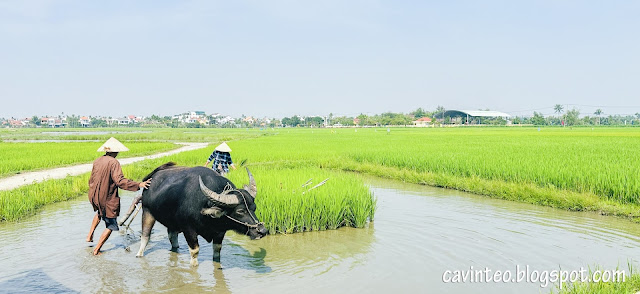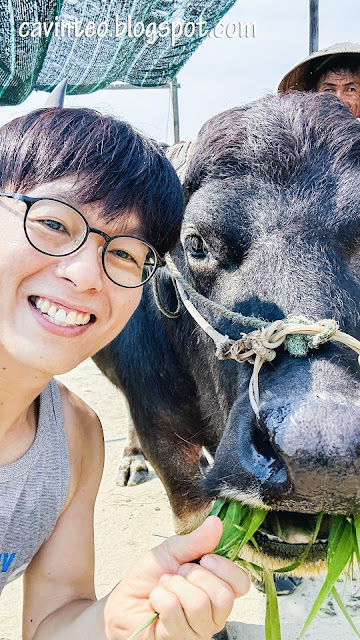We signed up for a Hoi An Village Experience Cycling Day Tour that was incredibly fun, and one of the highlights was the visit to a local padi farm, where we learnt more about rice planting and Vietnam's national animal; the water buffalo!
Star animal for the day; Say, a seven years old water buffalo that had been in this touristy job since he was two years of age! This occupation provided him with sufficient resources to have a wife and a daughter!
Despite his 600-kilogram weight, Say was docile amd a gentle giant! Well, giant might be the wrong choice of word as water buffaloes in the wild can weight up to 2,500 kilograms and about seven feet tall.
Instead of a nose ring, it was a rope that went into his nostrils; necessary to control him although I bet animal lovers would likely protest against such animal cruelty.
Hooves of a domesticated water buffalo; quite small and I wonder how they supported the weight! And you don't think they are slow; they have an average speed of almost 50 kilometers an away!
Add in the large, pointy horns and you could probably guess how dangerous it would be if you attempt to piss off Say! I remember in some places, the horns would also be used to make into combs and gua sha scraping tools!
Showing us the lower, yellowed teeth of Say! Do you know that water buffalos have an upper jaw with no teeth?! I am quite surprised as I thought you would require teeth on both jaws in order to chew?!
Feeling the skin of the water buffalo; many short, stiff bristles. Water buffalo leather can be used to make into drums and wallets although I figured they were more worth their money in traditional farming.
First time on a water buffalo! Do you know that I have never even ridden on a horse before? Lucky of Say to take away my virgin experience! Hahaha. I almost hurt my butt as I didn't know Say had such a hard butt that knocked against mine when I jumped on him!
After which was a short ride on Say under the hot sun! Thankfully a non-la was provided. Anyway, imagine if I have a free control of Say to see how fast he can run with his short legs.
Say was brought into the waterlogged padi field.
And we were asked to follow suit, in batches!
Honestly, I was glad that La Charm Hoi An Hotel & Spa provided slippers that we can wear outdoors! It would have been troublesome to remove my socks and covered shoes, and then to wear them back after the activity.
Undertaking the life of a farmer by working the water buffalo on the padi fields! In pairs of two, the above was a tour mate of us who had to pull Say on a ploughing route that encircled the crop in the centre.
After which to switch places so you can experience the role of being the one managing the plough at the back; looked easy from the onlooker perspective.
Now's our turn and boy was it hard work!
Switched positions. I am so glad to be an urbanite as it's pretty hard to walk in the waterlogged field, and the plough will be stuck if the soil was too thick or it hit a stone.
Leveling the soil with a tool shaped like a scraper!
Planting the seedlings 4 to 5 centimeters into the soil; another back breaking chore and I only had about 10 seedlings to plant! Do you know one seedling can bear how many grains of rice? I shall share later.
Washing the soil off our feet, with the help of the auntie working there! Those wearing socks and covered shoes should consider bringing a small towel to dry their feet.
Above was a single stalk of matured rice which took about 4 months in the field to mature; one stalk, two branches with about 50 grains per branch. One bowl of rice contained about 2,500 grains which means a year's supply would require 912,500 grains; translating into 9,125 stalks of rice! And I only planted ten stalks! We should really treasure the food that we eat and in this case, every rice grain served to us shouldn't be wasted!
Rice seedling in the germination stage.
While the rice grains would be sold as food for humans, the stalks have numerous uses; as materials for shelter, as fuel for cooking, as fertilizer and also as a meal for the water buffaloes.
Feeding time; and don't you assume that the water buffaloes would eat everything. They were aware that the soil section wasn't as palatable and would "cut" it off. You may refer to my video here to check it out.
Photo-taking time!
All thanks to the nice couple who made the activity so fun and meaningful! And of course, to our amazing tour guide, Hoang, who articulated all the information in a simple way for us urbanites!
Short video for your viewing pleasure.
=====
Additional Information
Part of the Hoi An Village Experience Cycling Day Tour



































%20&%20Hoi%20An%20(The%20City%20of%20Lanterns)%20in%20Vietnam.JPG)
No comments:
Post a Comment